Bodhipaksa's Blog, page 73
May 16, 2012
The Meditative Mind, by Daniel Goleman
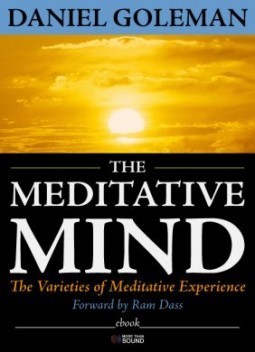 The Meditative Mind is an updated version of a book Daniel Goleman first published in the 1970s and revised in the 1980s. Goleman, who’s famous for his classic, Emotional Intelligence, was in on the first wave of research into the effects of meditation, having made a visit to India and having met some impressive yogis before returning to Harvard. Goleman has been ahead of the curve for a long time. This earlier parts of this book, he points out, first appeared at a time when the links between traditional Asian systems of mental training and modern psychological science were few and far between. They are of course far more common now, with an explosion of research having taken place over the last two decades in particular.
The Meditative Mind is an updated version of a book Daniel Goleman first published in the 1970s and revised in the 1980s. Goleman, who’s famous for his classic, Emotional Intelligence, was in on the first wave of research into the effects of meditation, having made a visit to India and having met some impressive yogis before returning to Harvard. Goleman has been ahead of the curve for a long time. This earlier parts of this book, he points out, first appeared at a time when the links between traditional Asian systems of mental training and modern psychological science were few and far between. They are of course far more common now, with an explosion of research having taken place over the last two decades in particular.
To take account of at least some of these developments, new material has been added, detailing some of the history of the encounter between meditation, on the one hand, and science and psychotherapeutic traditions on the other.
Title: The Meditative Mind: The Varieties of Meditating Experience
Author: Daniel Goleman
Publisher: More Than Sound
ISBN: Unknown
Available from: Amazon.co.uk Kindle Store, and Amazon.com Kindle Store.
The Meditative Mind is uneven in tone, but this is to be expected given that it’s a compilation of writings spanning several decades and having been composed for a variety of purposes and circumstances. The book is in five parts.
Part One: The Visuddhimagga: A Map for Inner Space
The first chapter, on Buddhaghosa’s Vissuddhimagga, gives a comprehensive and useful overview of the sophisticated psychological theory that underpins practice in Theravadin Buddhism. Since I was already familiar with most of this material, I didn’t find this chapter particularly engaging. I’m also very aware that the commentarial tradition, including Buddhaghosa, departed significantly from the teaching found in the (much earlier) scriptural tradition, and I found that there was a skeptical barrier between me and my appreciation of this particular chapter.
However, to be fair, the point of the chapter is to present an overview of classic Theravadin spiritual orthodoxy, and not to critique it. The chapter performs its task well, and gives an impressive survey of the Asian tradition’s systematic approach to spirituality. What is outlined here is a comprehensive schema of the progress of spiritual development, and given the vague terms in which people tend to think about such matters, this chapter will no doubt surprise and enlighten many readers.
Part Two: Meditation Paths: A Survey
At the risk of making Dr. Goleman feel very old, The Meditative Mind, as far as the earlier material goes, constitutes a valuable historical document. Part Two of the book offers an overview of a number of meditative traditions: Hindu Bakti meditation, Jewish meditation, Christian meditation, Sufism, Patanjali’s Yoga tradition, Tantra, Tibetan Buddhism, and Zen. For me this was the most fascinating part of the book. In fact I’d go as far as to say it’s one of the most eye-opening spiritual documents I’ve read.
The commonalities between the various traditions are immense, and I came away with a deep respect for non-Buddhist traditions. It’s clear that within Christianity, Judaism, Islam, etc., there have been deep currents of meditative experience, and correspondingly deep insights. I’m convinced now that there have been enlightened practitioners in many traditions besides Buddhism — something I hadn’t really contemplated before. I still consider other traditions to be hampered by their theological baggage, however, and for that reason I do still consider the Buddha’s insight to have gone further than others’, but I am still humbled and reverential toward the Desert Fathers and other non-Buddhist meditators.
Part Three: Meditation Paths: Their Essential Unity
The third part of the book gives a brief outline of some of the commonalities (and divergences) of the various meditative paths, although the emphasis is on their essential unity. Particularly useful was the categorization of meditative techniques into those that involve concentration, “in which the mind focuses on a fixed mental object,” mindfulness, “in which mind observes itself,” and integrated, in which both functions are present simultaneously. As Goleman points out, few schools take a purist approach, and employ whatever means are found to be helpful. This is a valuable reminder not to cling dogmatically to one approach to practice, but to retain a pragmatic approach.
Part Four: The Psychology of Meditation
Part Four examines the spiritual psychology of meditation, and its “potential for cross-fertilization with western psychology.” It was originally written for psychologists in order to introduce them to non-Western systems of psychological theory. The Buddhist scholastic tradition of the Abhidhamma, which attempted to systematize and clarify the Buddha’s teachings, is the main focus. The overview of Abhidhamma (unlike the Abhidhamma itself!) is engrossing, and offers an overview of Buddhist personality theory, and a map of the Buddhist conception of mental health. The enlightened individual is then presented as the examplar of religious views of the ideal of human “peak performance” and this is contrasted with the history of western psychology’s obsession with psychological disfunction, and compared with the way in which some western psychological theory has sometimes seen the healthy individual in terms very similar to those of the Buddhist tradition.
Part Five: Meditation: Research and Practical Applications
The final section of Meditative Mind offers an overview of some of the impressive findings from meditation studies. The degree to which meditation is able to affect our physiology and psychology — from enhancing the ability to recover from stressful incidents to affecting the immune system — is staggering. This section however, absorbing though it is, seems dated, with no reference to studies after the early 1980′s. Given the huge body of research that has taken place since that time, this is a puzzling omission. Dr. Goleman is well placed to offer such an overview.
So, overall my opinion of The Meditative Mind is mixed. One the one hand it contains much thought-provoking material on comparative psychology. On the other hand it doesn’t bring us up to date on the west’s embrace of meditative practice. There is no mention of Mindfulness-Based Stress Reduction, for example, or of the many therapeutic techniques that it has given rise to. On balance, the book is certainly worth reading, although readers will want to turn to Goleman’s The Brain and Emotional Intelligence to get an overview of how the dialog between meditation and modern neuroscience, and Ed Halliwell’s The Mindful Manifesto provides an excellent survey of how meditative practices are transforming therapeutic approaches.
May 9, 2012
In sitting still, a bench press for the brain
 John Hanc, New York Times: In 1969, Katherine Splain, then a student at the College of New Rochelle, saw the dark side of drug use among her peers. So she sought a different — and legal — path on her inward journey.
John Hanc, New York Times: In 1969, Katherine Splain, then a student at the College of New Rochelle, saw the dark side of drug use among her peers. So she sought a different — and legal — path on her inward journey.
“I had read that meditation was actually another way of achieving the kind of ‘high’ that you might experience if you did drugs,” said Ms. Splain, who is now 63.
She heard about a class in meditation being offered near the school, decided to visit and was impressed with the students she met. “There wasn’t a lot of peace in the world in 1969 …
Gandharan Buddha seated in meditation, Seattle Asian Art Museum
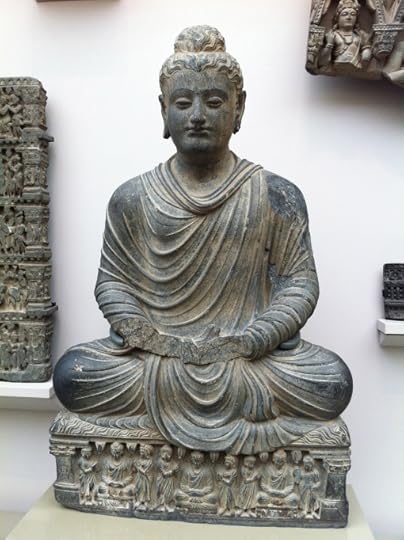
Another Greco-Indian statue from Gandhara.
Notice the beautiful carved base, which itself contains three Buddha figures along with attendants.
May 8, 2012
Buddha image, Seattle Buddhist Center
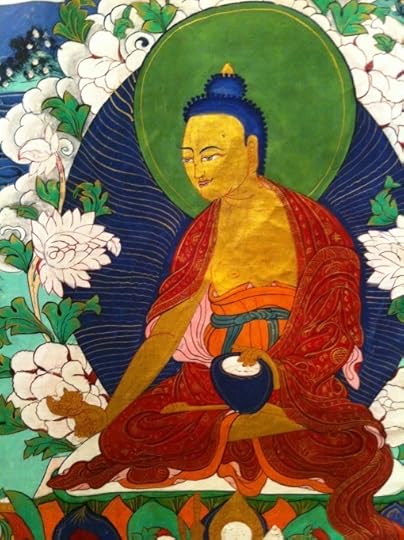
I took this detail of a Tibetan Thangka painting on my iPhone at the Seattle Buddhist Center just before doing a workshop on the Satipatthana Sutta with the men’s sangha there tonight.
Last night I gave a talk and led a meditation at the Buddha Day celebrations, where we commemorate the Buddha’s enlightenment.
May 6, 2012
Bodhisattva at the Seattle Asian Art Museum
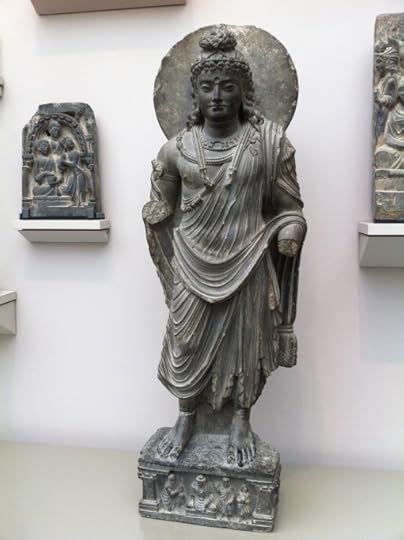
I snapped this on my iPhone yesterday at Seattle’s Asian Art Museum. The pose and style of the statue look Greco-Roman because they are. It’s a Gandharan statue of the Buddha before his enlightenment. Gandhara, now in Pakistan, was in the Classical Greek sphere of interest, and it’s where the first Buddha images were made.
May 3, 2012
Fake Buddha Quote: “Let us rise up and be thankful, for if we didn’t learn a lot today, at least we learned a little…”
On May 3, 2012, at 4:17 AM, Jundo Cohen wrote:
Name: Jundo Cohen
Email: Jundo … .com
Subject: Fake Buddha Quote
Message: Hello,
I have another quote floating around the internet that strikes me as
something the Buddha wouldn’t be caught dead saying …
Let us rise up and be thankful, for if we didn’t learn a lot today,
at least we learned a little, and if we didn’t learn a little, at
least we didn’t get sick, and if we got sick, at least we didn’t
die; so, let us be thankful.
-The Buddha
You’re absolutely right, Jundo. This is not the kind of language or idiom that the Buddha used.
The original source is Leo Buscaglia’s 1992 book, “Born for Love: Reflections on Loving,” where he writes:
‘Years ago I had a Buddhist teacher in Thailand who would remind all his students that there was always something to be thankful for. He’d say, “Let’s rise and be thankful, for if we didn’t learn a lot today, at least we may have learned a little. And if we didn’t learn even a little, at least we didn’t get sick. And if we did get sick, at least we didn’t die. So let us all be thankful.’ (page 102)
I’m actually a little dubious that a Thai monk would use the idiom “rise up and be thankful” — “rise up” in what sense? — but it’s good to have a source.
All the best,
Bodhipaksa
Related posts:
Fake Buddha Quote: “Each morning we are born again. What we do today is what matters most.”
Fake Buddha Quote: “When words are both true and kind, they can change our world.”
Fake Buddha Quote: “It is better to travel well than to arrive.”
April 27, 2012
It’s a sign!
As I arrived at work today, the signmakers were just starting to hang Wildmind’s new sign outside of the mill building that we moved into back in February. We’re very pleased with the way it looks.







April 25, 2012
There is a crack in everything / That’s how the light gets in
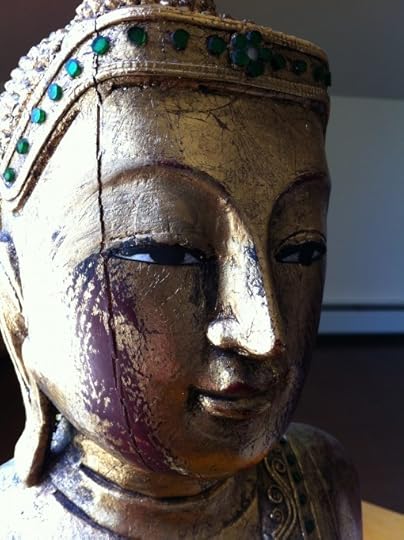
Ring the bells that still can ring
Forget your perfect offering
There is a crack in everything
That’s how the light gets in.
From “Anthem,” by Leonard Cohen.
April 24, 2012
“Monkey mind?” Who, me?

The UK’s Daily Mail has a collection of photographs of this meditating lemur, taken by Belgian-born amateur photographer Sebastian Degardin, who lives in Finchley, north London.
The photographs were taken on a forest path in a nature park in Mons, Belgium.
Taking care of the present moment
“Why do we have to take care of the present moment? It is where all the wonder is possible. You cannot go to the past and drink a cup of tea. You cannot go to the future to drink a cup of tea. But now, we are drinking a cup of tea.” ~ Brother Phap Huy
From this news article.
Related posts:
Back to the Present: How to Live in the Moment
Six Steps to Living in the Moment
Awareness of impermanence heightens appreciation of the present



